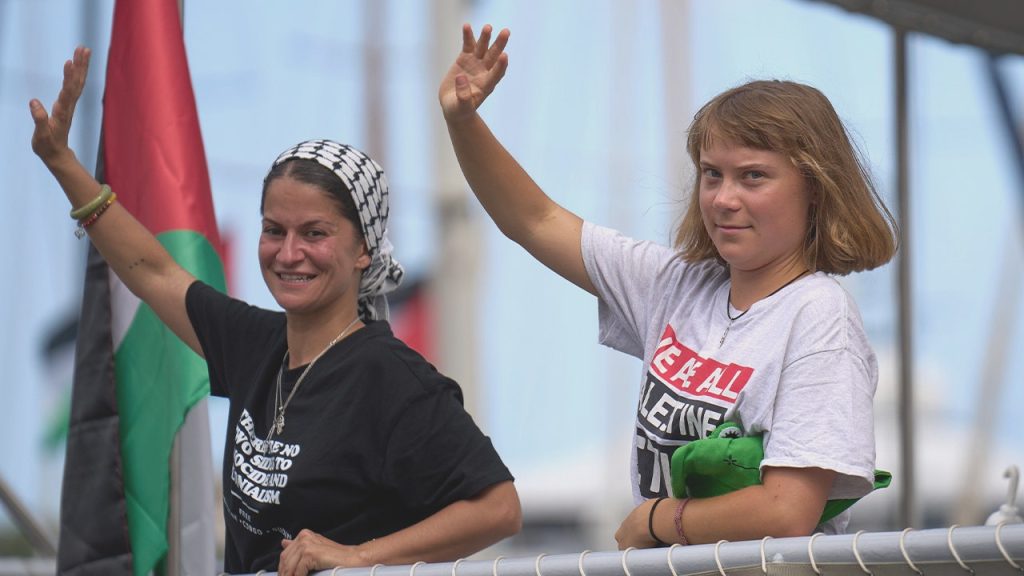Humanitarian Flotilla Faces Significant Challenges in Gaza Aid Mission
In a bold but potentially futile humanitarian effort, Greta Thunberg has launched her second flotilla from Barcelona toward Gaza, accompanied by notable figures including “Game of Thrones” actor Liam Cunningham and former Barcelona mayor Ada Colau. The Global Sumud Flotilla, comprising approximately 70 vessels carrying essential supplies like food, water, and medicine, aims to reach Gaza by mid-September. However, maritime experts have raised serious doubts about the mission’s feasibility, pointing to Gaza’s lack of adequate docking facilities and Israel’s maritime security measures. Professor James Kraska, an expert in maritime law from the U.S. Naval War College, explained that Gaza simply lacks the port infrastructure necessary to accommodate such a large flotilla. “There aren’t any port facilities in this area to unload anything,” he noted, adding that even the small fishing port would be inadequate for the task. He also referenced the United States’ previous attempt to construct a temporary port at a cost of $200 million, which was ultimately dismantled due to challenging weather conditions in the region. This history suggests that even with the best intentions, the physical delivery of aid via this route faces overwhelming practical obstacles.
The humanitarian crisis driving this mission cannot be overstated, with the Hamas-run Gaza Ministry of Health reporting over 63,000 casualties since the conflict began. At the Barcelona press conference before departure, Thunberg framed the mission in stark terms of survival: “The story here is about Palestine. The story here is how people are being deliberately deprived of the very basic means to survive.” She accused Israel of violating international law by “unlawfully intercepting boats in international waters” and preventing essential aid from reaching civilians in desperate need. This mission represents Thunberg’s second attempt to deliver humanitarian assistance by sea, following a failed effort in June when Israeli forces stopped her ship, the Madleen, resulting in her deportation along with 11 others aboard. The persistence of these efforts highlights the growing international concern about the humanitarian situation in Gaza, even as questions remain about the effectiveness of such maritime initiatives.
The legal and security dimensions of this situation add another layer of complexity. Professor Kraska emphasized that Israel’s maritime security operations, which function effectively as a blockade, constitute a lawful measure during armed conflict—provided they meet specific requirements including proper notice, effectiveness, and impartial enforcement. “Ultimately, there is authority for Israel to defend the blockade,” Kraska explained, while acknowledging that the situation encompasses more than just legal considerations. “It’s not just the law—politics and practical realities are involved as well. Both sides are weighing those dimensions.” Israel maintains its position that preventing ships from docking represents a legitimate security measure during wartime, setting the stage for another potential interception when Thunberg’s flotilla approaches Gaza waters, regardless of its humanitarian intent.
The humanitarian situation in Gaza has deteriorated significantly throughout the ongoing conflict, creating conditions that have prompted these extraordinary measures from international activists. With essential supplies dwindling and infrastructure damaged or destroyed, Gaza’s civilian population faces severe shortages of food, clean water, medicine, and fuel. International aid organizations have consistently reported difficulties in delivering assistance through conventional channels, citing security restrictions and bureaucratic obstacles. This humanitarian emergency has catalyzed grassroots responses like Thunberg’s flotilla, which seek alternative routes to deliver aid when traditional methods appear insufficient. However, these well-intentioned efforts often encounter the harsh realities of conflict zones, where security concerns, political considerations, and practical limitations create a complex web of challenges that humanitarian missions must navigate.
The Global Sumud Flotilla represents more than just a practical attempt to deliver aid—it also serves as a powerful symbol of international solidarity and a spotlight on the humanitarian crisis. By drawing media attention through the participation of celebrities and public figures, the mission raises awareness about conditions in Gaza regardless of whether the supplies actually reach their intended recipients. This symbolic dimension shouldn’t be underestimated, as it may influence public opinion and potentially pressure various stakeholders to facilitate more effective aid delivery through conventional channels. However, critics argue that symbolic gestures, while valuable for awareness, don’t address the immediate needs of Gaza’s civilian population. This tension between practical humanitarian action and symbolic protest demonstrates the multifaceted nature of international responses to complex humanitarian emergencies, where both approaches may have different but complementary roles to play.
As the flotilla makes its way toward Gaza, the coming weeks will reveal whether this humanitarian mission can overcome the formidable obstacles in its path. The Israeli Defense Forces have already indicated they will “maintain a security perimeter out in the water to protect the beaches of Gaza,” as Professor Kraska noted, suggesting another interception is likely. Meanwhile, diplomatic efforts continue in parallel, seeking sustainable solutions to both the immediate humanitarian crisis and the underlying conflict. What remains clear is that regardless of the flotilla’s ultimate fate, the desperate situation in Gaza demands immediate attention and effective action from the international community. As Professor Kraska wisely observed, “There is not one controlling narrative: there is international law, the political situation and the tactical dimension.” This multifaceted reality requires comprehensive approaches that address not only the symptoms but also the causes of the humanitarian emergency, while respecting both security concerns and the fundamental human rights of all involved.


